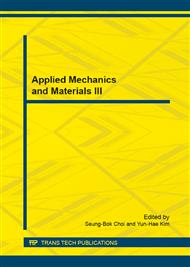[1]
Lubinski, A: Developments in Petroleum Engineering, Gulf Publishing, Houston, Vol 1, (1987).
Google Scholar
[2]
Murphey, C. E. and Cheatham, J. B.: Hole Deviation and Drill String Behavior, paper SPE 1259 presented at the 40th Annual Meeting of the SPE, Denver, CO, October 3-6, (1965).
Google Scholar
[3]
Nicholson, RW., Jr.: Analysis of Constrained Directional Drilling Assemblies, Ph.D. Dissertation, The University of Tulsa, Department of Petroleum Engineering, (1972).
Google Scholar
[4]
Fischer, J. F.: Analysis of Drillstrings in Curved Boreholes, paper SPE 5071 presented at the 49th Annual Meeting of the SPE, Houston, TX, October 6-9, (1974).
Google Scholar
[5]
Millheim, K, Jordan, S., and Ritter, C.: Bottom - Hole Assembly Analysis Utilizing the Finite Element Method, paper SPE 6057 presented at the 51st Annual Fall Conference of the SPE, New Orleans, LA, October 3-6, (1976).
Google Scholar
[6]
Baird, J. A, et at: GEODYN: A Geological Formation/Drillstring Dynamics Computer Program, - paper SPE 13023 presented at the 59th Annual Technical Conference and Exhibition of the SPE, Houston, TX, September 16-19, (1984).
DOI: 10.2118/13023-ms
Google Scholar
[7]
Williamson, J. S. and Lubinski, A.: Predicting Bottom hole Assembly Performance, paper SPE 14764 presented at the 1986 IADC/SPE Drilling Conference, Dallas, TX, February 10-12, (1986).
Google Scholar
[8]
Rafie, S., Ho, H. S., and Chandra, U.: Applications of a BHA Analysis Program in Directional Drilling, paper SPE 14765 presented at the 1986 IADC/SPE Drilling Conference, Dallas, TX, February 10-12, (1986).
DOI: 10.2118/14765-ms
Google Scholar
[9]
Brett, J. F. et al.: A Method of Modeling the Directional Behavior of Bottom hole Assemblies Including Those with Bent Subs and Downhole Motors, paper SPE 14767 presented at the 1986 IADC/SPE Drilling Conference, Dallas, TX, and February 10-12, (1986).
DOI: 10.2118/14767-ms
Google Scholar
[10]
Jogi, P. M., Burgess, T. M., and Bowling, J. P.: Predicting the Build/Drop Tendency of Rotary Drilling Assemblies, SPE Drilling Engineering, (June 1988), pp. 1n-185.
DOI: 10.2118/14768-pa
Google Scholar
[11]
Birades, M.: Static and Dynamic Three-Dimensional Bottom hole Assembly Computer Models, SPE Drilling Engineering, (June 1988), pp.160-166.
DOI: 10.2118/15466-pa
Google Scholar
[12]
Ho, H. S.: General Formulation of Drillstring Under Large Deformation and Its Use in BHA Analysis, paper SPE 15562 presented at the 61 a Annual Technical Conference and Exhibition of the SPE, New Orleans, LA, October 5-8, (1986).
DOI: 10.2118/15562-ms
Google Scholar
[13]
Brakel, J. D., and Azar, J. J.: Prediction of Wellbore Trajectory Considering Bottom hole Assembly and Drill Bit Dynamics, Ph.D. Dissertation, The University of Tulsa, Department of Petroleum Engineering, (1986).
DOI: 10.2118/16172-pa
Google Scholar
[14]
Bradley, W. B.: Factors Affecting the Control of Borehole Angle in Straight and Directional Wells, paper SPE 5070 presented at the 49th Annual Meeting of the SPE, Houston, TX, and October 6-9, (1974).
Google Scholar
[15]
Cheatham, J. B. and Ho, C. Y.: A Theoretical Model for Directional Drilling Tendency of a Drill Bit in Anisotropic Rock, paper SPE 10642, (Unsolicited), September (1981).
Google Scholar
[16]
Paul A Larson· and J. J. Azar: THREE-DIMENSIONAL QUASI-STATIC. DRILL AHEAD BHA MODEL, SPE23530 in SPE Technical Paper, May 31 (1991).
Google Scholar
[17]
G. Robello Samuel: Formulas and Calculations for Drilling Operations,; Scrivener Publishing Wiley, (2010).
Google Scholar
[18]
Newman, K. R., & Procter, R. (2009).
Google Scholar
[19]
Yang, D., Rahman, M. K., & Chen, Y. (2008). Bottom hole assembly analysis by finite difference differential method. INTERNATIONAL JOURNAL FOR NUMERICAL METHODS IN ENGINEERIN. 74, 1495–1517. http: /dx. doi. org/10. 1002/nme. 2221.
DOI: 10.1002/nme.2221
Google Scholar


